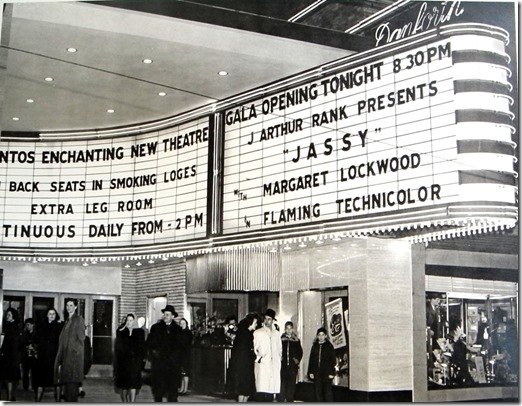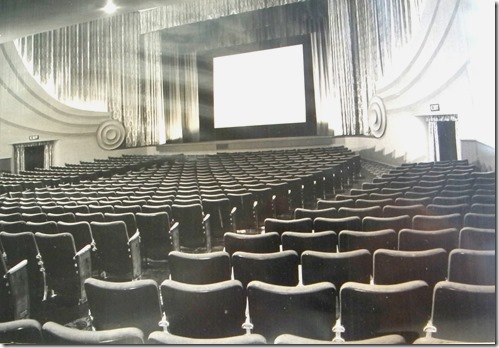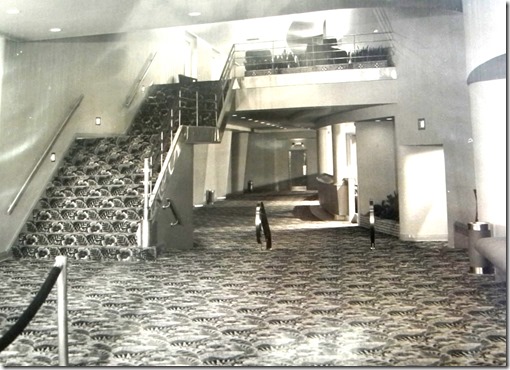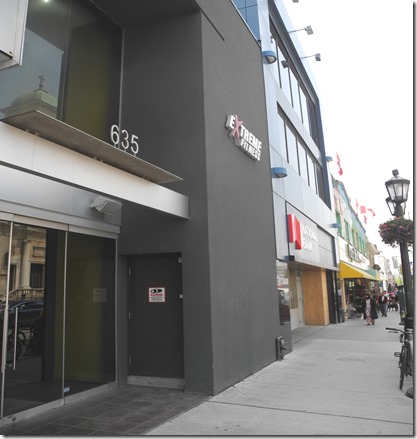Odeon Danforth Theatre, the film “Jassy” on the marquee. Released in 1947, it was a drama about an English squire and his daughter’s friendship with Jassy, a Gypsy psychic. Photo from City of Toronto Archives, Series 1278, File 119.
The Odeon Danforth is another of the movie theatres on the Danforth that I remember well, but never attended. However, I viewed it many times from the windows of the old Bloor PCC streetcars, which passed in front of the theatre. The Bloor cars were removed from service after the Bloor-Danforth Subway opened in 1966. The Odeon Danforth’s main rival was the Palace Theatre, located a short distance to the east of it. Both theatres are now long gone.
The Odeon chain of theatres entered the Toronto market to screen British films, but later showed Hollywood films as well. In the 1950s and 1960s, Odeon developed the policy of featuring the same films simultaneously in several of its theatres. As I lived nearer to the Odeon Humber, there was no need for me to journey to the east end of the city to view the films playing at the Odeon Danforth.
On a hot day in July 2014, I travelled on the subway to visit the site where the theatre had once stood, at 635 Danforth Avenue. Today, a branch of Extreme Fitness, an exercise gym, is on the location. The site is on the south side of Danforth Avenue, a short distance west of Pape Avenue.
The Odeon Danforth opened on April 16, 1947. Later the same year the Odeon chain opened the Odeon Toronto (Carlton) on September 9th, and the Odeon Hyland on November 22, 1948. The previous year, the company had opened the Odeon Fairlawn on Yonge Street. The following year they opened the Odeon Humber on January 7th. The Odeon Danforth was the only theatre they owned located east of the Don Valley.
The theatre was impressive, its massive marquee dominating the street. The modern glass doors were recessed a distance back from the street, creating an open space that formed a grand approach for patrons entering the theatre. This compensated for the theatre’s small frontage on The Danforth. The box office was outside, to the right of the doors. Since the theatre extended back a good distance from the street, there was space for an extensive lobby, which was richly carpeted, with a wide staircase leading to the balcony. Its auditorium was large, possessing over 1300 seats, including the ground-floor and the balcony. The seating on the main floor contained two aisles—a centre section and further seating on either side of the aisles. Surrounding the screen were rich folds of drapery, which created elegance, but also intimacy. The walls were decorated with sweeping decorative lines that accented its modernistic style.
When the demographics of the area changed, the theatre commenced showing Greek films and its name was changed to the Rex. Eventually the theatre was no longer profitable and it closed. Finally, the building was renovated for a fitness gym, but some of the interior architectural features of the theatre were maintained. Passing by the site of the Odeon Danforth today, it is difficult to conceive that there was once a grand theatre on the premises.
Ground-floor seating of the Odeon Danforth, with its sweeping decorative lines on the side walls and generous drapery near the screen. Photo Ontario Archives, AO 2142.
Lobby of the theatre, with the rich carpeting and the grand staircase to the balcony. Ontario Archives, AO 2141.
The fitness gym in 2014, at 635 Danforth Avenue, where the Odeon Danforth was located.
To view the Home Page for this blog: https://tayloronhistory.com/
To view previous blogs about movie houses of Toronto—historic and modern
Recent publication entitled “Toronto’s Theatres and the Golden Age of the Silver Screen,” by the author of this blog. The publication explores 50 of Toronto’s old theatres and contains over 80 archival photographs of the facades, marquees and interiors of the theatres. It relates anecdotes and stories of the author and others who experienced these grand old movie houses.
To place an order for this book:
Book also available in Chapter/Indigo, the Bell Lightbox Book Store and by phoning University of Toronto Press, Distribution: 416-667-7791
Theatres Included in the Book:
Chapter One – The Early Years—Nickelodeons and the First Theatres in Toronto
Theatorium (Red Mill) Theatre—Toronto’s First Movie Experience and First Permanent Movie Theatre, Auditorium (Avenue, PIckford), Colonial Theatre (the Bay), the Photodome, Revue Theatre, Picture Palace (Royal George), Big Nickel (National, Rio), Madison Theatre (Midtown, Capri, Eden, Bloor Cinema, Bloor Street Hot Docs), Theatre Without a Name (Pastime, Prince Edward, Fox)
Chapter Two – The Great Movie Palaces – The End of the Nickelodeons
Loew’s Yonge Street (Elgin/Winter Garden), Shea’s Hippodrome, The Allen (Tivoli), Pantages (Imperial, Imperial Six, Ed Mirvish), Loew’s Uptown
Chapter Three – Smaller Theatres in the pre-1920s and 1920s
Oakwood, Broadway, Carlton on Parliament Street, Victory on Yonge Street (Embassy, Astor, Showcase, Federal, New Yorker, Panasonic), Allan’s Danforth (Century, Titania, Music Hall), Parkdale, Alhambra (Baronet, Eve), St. Clair, Standard (Strand, Victory, Golden Harvest), Palace, Bedford (Park), Hudson (Mount Pleasant), Belsize (Crest, Regent), Runnymede
Chapter Four – Theatres During the 1930s, the Great Depression
Grant ,Hollywood, Oriole (Cinema, International Cinema), Eglinton, Casino, Radio City, Paramount, Scarboro, Paradise (Eve’s Paradise), State (Bloordale), Colony, Bellevue (Lux, Elektra, Lido), Kingsway, Pylon (Royal, Golden Princess), Metro
Chapter Five – Theatres in the 1940s – The Second World War and the Post-War Years
University, Odeon Fairlawn, Vaughan, Odeon Danforth, Glendale, Odeon Hyland, Nortown, Willow, Downtown, Odeon Carlton, Donlands, Biltmore, Odeon Humber, Town Cinema
Chapter Six – The 1950s Theatres
Savoy (Coronet), Westwood
Chapter Seven – Cineplex and Multi-screen Complexes
Cineplex Eaton Centre, Cineplex Odeon Varsity, Scotiabank Cineplex, Dundas Square Cineplex, The Bell Lightbox (TIFF)




![cid_E474E4F9-11FC-42C9-AAAD-1B66D852[2] cid_E474E4F9-11FC-42C9-AAAD-1B66D852[2]](https://tayloronhistory.com/wp-content/uploads/2015/03/cid_e474e4f9-11fc-42c9-aaad-1b66d8522_thumb3.jpg)


Hi Doug:
I grew up on the Danforth and know these theatres well. Regarding the Odeon Theatre, now a fitness centre, I encourage you to visit the interior. The “bones” of the old theatre are still visible: a white wall where the screen was, the balcony, the boxes and main floor all hold gym equipment, but they are on different levels. Even the projection room area has been kept, although enlarged, and has yoga classes.
Cheers, Katherine